warning TOYOTA 86 2019 Owners Manual
[x] Cancel search | Manufacturer: TOYOTA, Model Year: 2019, Model line: 86, Model: TOYOTA 86 2019Pages: 532, PDF Size: 6.89 MB
Page 3 of 532
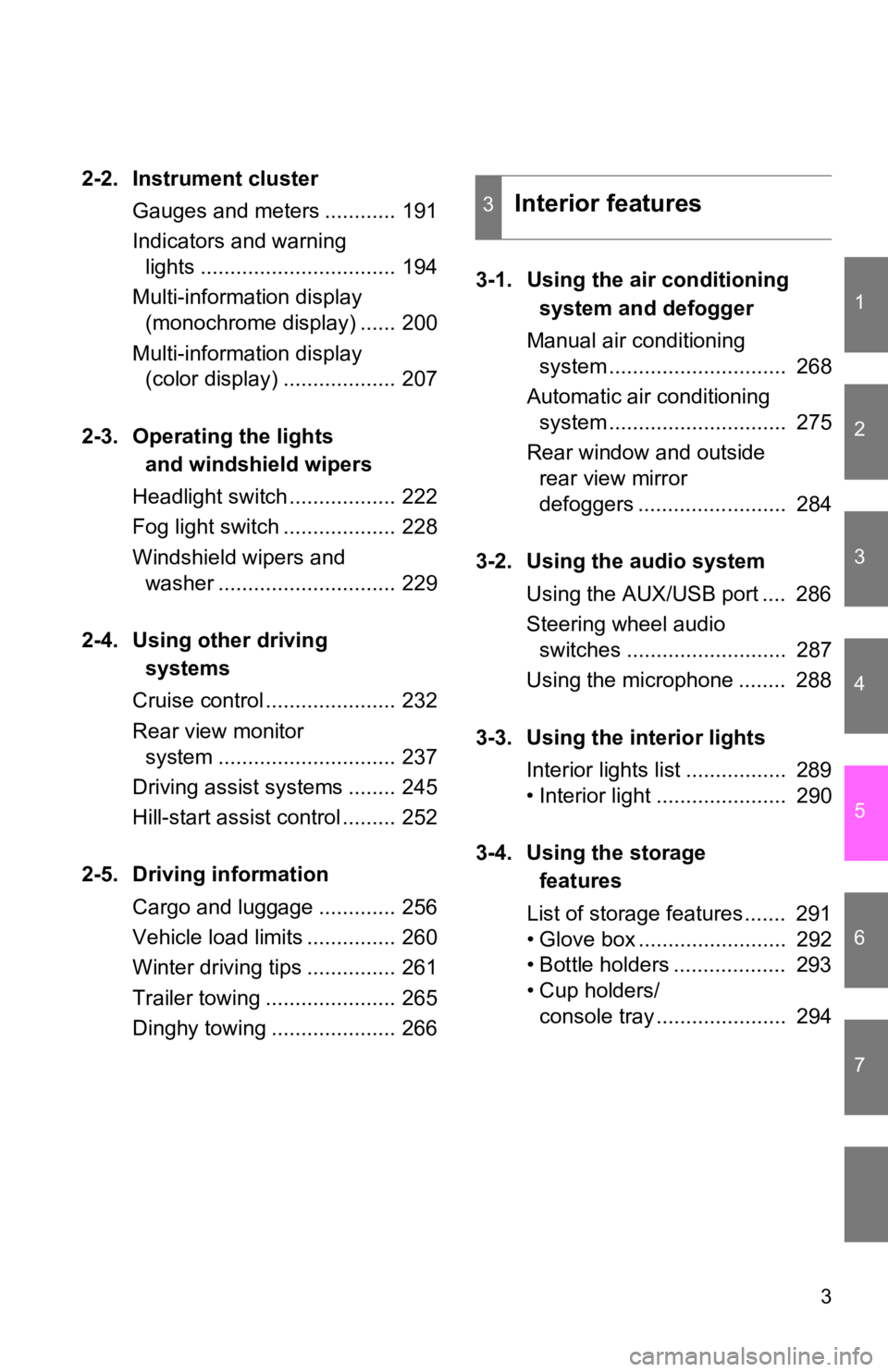
1
2
3
4
5
6
7
32-2. Instrument cluster
Gauges and meters ............ 191
Indicators and warning
lights ................................. 194
Multi-information display
(monochrome display) ...... 200
Multi-information display
(color display) ................... 207
2-3. Operating the lights
and windshield wipers
Headlight switch .................. 222
Fog light switch ................... 228
Windshield wipers and
washer .............................. 229
2-4. Using other driving
systems
Cruise control ...................... 232
Rear view monitor
system .............................. 237
Driving assist systems ........ 245
Hill-start assist control ......... 252
2-5. Driving information
Cargo and luggage ............. 256
Vehicle load limits ............... 260
Winter driving tips ............... 261
Trailer towing ...................... 265
Dinghy towing ..................... 266 3-1. Using the air conditioning
system and defogger
Manual air conditioning
system .............................. 268
Automatic air conditioning
system .............................. 275
Rear window and outside
rear view mirror
defoggers ......................... 284
3-2. Using the audio system
Using the AUX/USB port .... 286
Steering wheel audio
switches ........................... 287
Using the microphone ........ 288
3-3. Using the interior lights
Interior lights list ................. 289
• Interior light ...................... 290
3-4. Using the storage
features
List of storage features ....... 291
• Glove box ......................... 292
• Bottle holders ................... 293
• Cup holders/
console tray ...................... 2943
Interior features
Page 5 of 532

1
2
3
4
5
6
7
55-2. Steps to take in an
emergency
If a warning light turns on
or a warning buzzer
sounds... ........................... 395
If a warning message is
displayed........................... 407
If you have a flat tire............ 424
If the engine will not start .... 435
If the shift lever cannot be
shifted from P.................... 438
If you lose your keys ........... 439
If the electronic key does
not operate properly.......... 440
If the battery is
discharged ........................ 444
If your vehicle overheats ..... 449
If the vehicle becomes
stuck ................................. 452
If your vehicle has to be
stopped in an
emergency ........................ 454 6-1. Specifications
Maintenance data
(fuel, oil level, etc.) ........... 458
Fuel information.................. 470
Tire information .................. 474
6-2. Customization
Customizable features........ 487
Reporting safety defects
for U.S. owners ................ 492
Seat belt instructions
for Canadian owners
(in French) ........................ 493
SRS airbag instructions
for Canadian owners
(in French) ........................ 496
Abbreviation list ........................ 520
Alphabetical index .................... 521
What to do if... .......................... 529 6
Vehicle specifications
7
For owners
Index
Page 19 of 532

19Scrapping of your Toyota The SRS airbag and seat belt pretensioner devices in your Toyot a contain
explosive chemicals. If the vehicle is scrapped with the airbags and seat belt
pretensioners left as they are, this may cause an accident such as fire. Be
sure to have the systems of the SRS airbag and seat belt preten sioner
removed and disposed of by a qualified service shop or by your To y o t a
dealer before you scrap your vehicle.
Perchlorate Material Special handling may apply, See www.dtsc.ca.gov/hazardouswaste/ perchlorate.
Your vehicle has components that may contain perchlorate. These
components may include airbag, seat belt pretensioners, and wir eless
remote control batteries.
WARNING■ General precautions while driving
Driving under the influence: Never drive your vehicle when unde r the influ-
ence of alcohol or drugs that have impaired your ability to ope rate your vehi-
cle. Alcohol and certain drugs delay reaction time, impair judg ment and
reduce coordination, which could lead to an accident that could result in
death or serious injury.
Defensive driving: Always drive defensively. Anticipate mistake s that other
drivers or pedestrians might make and be ready to avoid acciden ts.
Driver distraction: Always give your full attention to driving. Anything that dis-
tracts the driver, such as adjusting controls, talking on a cel lular phone or
reading can result in a collision with resulting death or serio us injury to you,
your occupants or others.
■ General precaution regarding children’s safety
Never leave children unattended in the vehicle, and never allow children to
have or use the key.
Children may be able to start the vehicle or shift the vehicle into neutral.
There is also a danger that children may injure themselves by p laying with
the windows or other features of the vehicle. In addition, heat build-up or
extremely cold temperatures inside the vehicle can be fatal to children.
Page 20 of 532
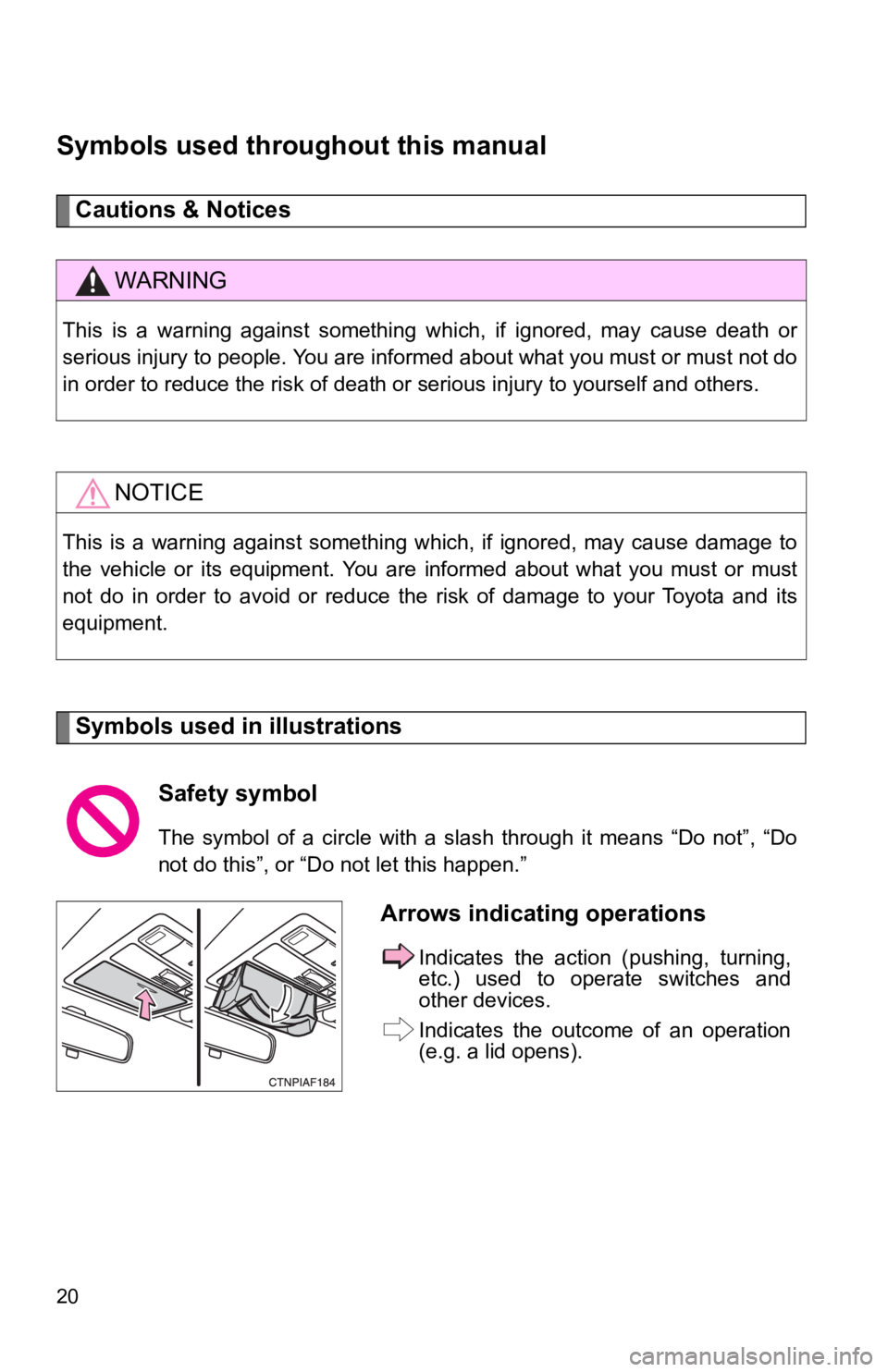
20Symbols used thr oughout this manualCautions & Notices
Symbols used in illustrations WARNINGThis is a warning against something which, if ignored, may caus e death or
serious injury to people. You are informed about what you must or must not do
in order to reduce the risk of death or serious injury to yourself and others.
NOTICEThis is a warning against something which, if ignored, may caus e damage to
the vehicle or its equipment. You are informed about what you m ust or must
not do in order to avoid or reduce the risk of damage to your T oyota and its
equipment.
Safety symbol The symbol of a circle with a slash through it means “Do not”, “Do
not do this”, or “Do not let this happen.”
Arrows indicating operations Indicates the action (pushing, turning,
etc.) used to operate switches and
other devices.
Indicates the outcome of an operation
(e.g. a lid opens).
Page 29 of 532
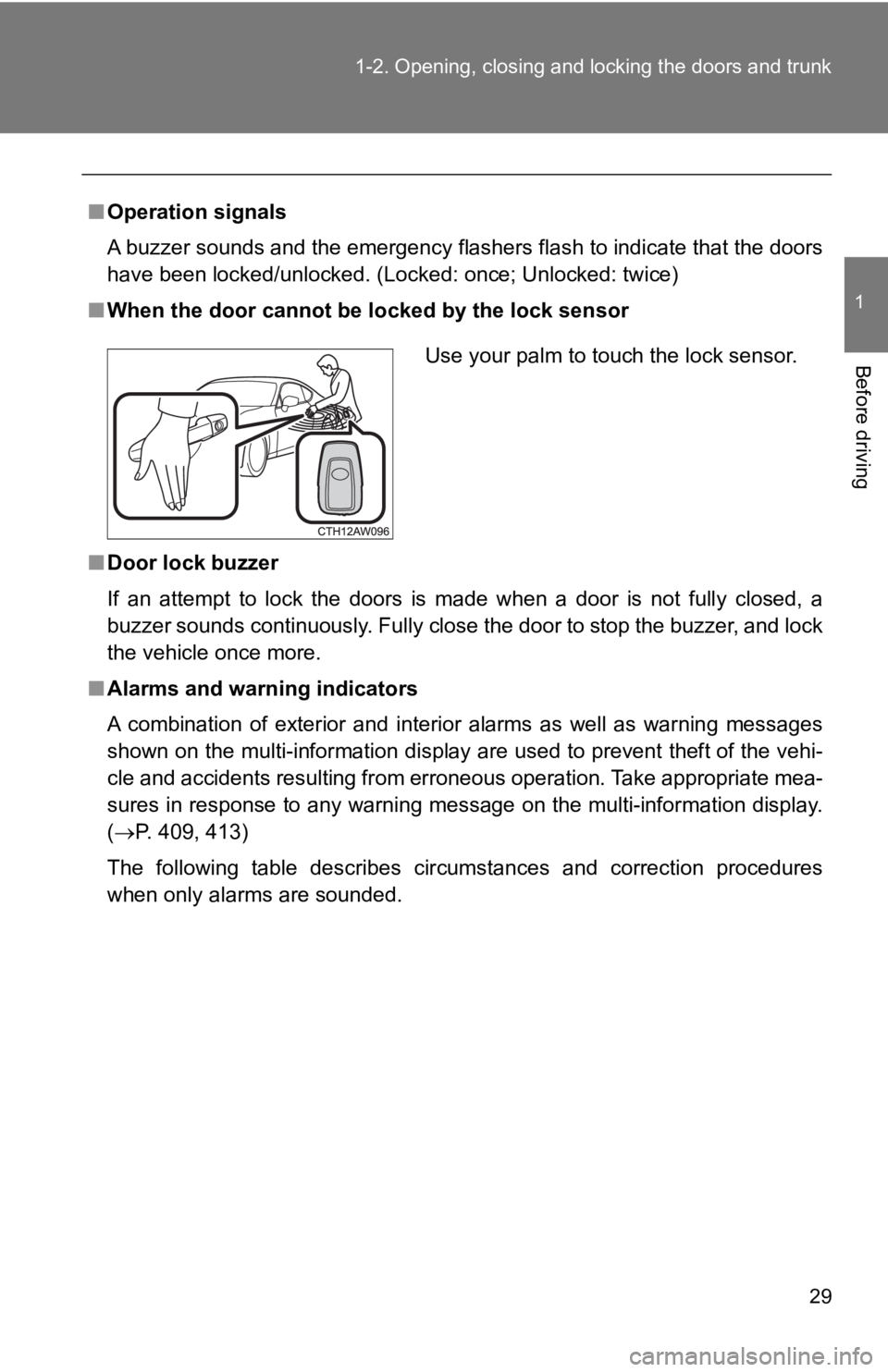
291-2. Opening, closing and locking the doors and trunk
1
Before driving ■ Operation signals
A buzzer sounds and the emergency flashers flash to indicate that the doors
have been locked/unlocked. (Locked: once; Unlocked: twice)
■ When the door cannot be locked by the lock sensor
■ Door lock buzzer
If an attempt to lock the doors is made when a door is not full y closed, a
buzzer sounds continuously. Fully close the door to stop the bu zzer, and lock
the vehicle once more.
■ Alarms and warning indicators
A combination of exterior and interior alarms as well as warnin g messages
shown on the multi-information display are used to prevent thef t of the vehi-
cle and accidents resulting from erroneous operation. Take appr opriate mea-
sures in response to any warning message on the multi-informati on display.
( P. 409, 413)
The following table describes circumstances and correction proc edures
when only alarms are sounded. Use your palm to touch the lock sensor.
Page 36 of 532

361-2. Opening, closing and locking the doors and trunk
■ Certification for smart key system
For vehicles sold in the U.S.A.
FCC ID: HYQ23AAE FCC ID: HYQ14AHP
FCC ID: Y8PSSPLF03
NOTE:
This device complies with part 15 of the FCC Rules. Operation i s subject to
the following two conditions: (1) This device may not cause har mful interfer-
ence, and (2) this device must accept any interference received, including
interference that may cause undesired operation.
FCC WARNING:
Changes or modifications not expressly approved by the party re sponsible
for compliance could void the user's authority to operate the equipment.
For vehicles sold in Canada
NOTE:
This device complies with Industry Canada’s licence-exempt RSSs . Opera-
tion is subject to the following two conditions: (1) This devic e may not cause
interference; and (2) This device must accept any interference, including
interference that may cause undesired operation of the device.
NOTE:
Le présent appareil est conforme aux CNR d’Industrie Canada app licables
aux appareils radio exempts de licence. L’exploitation est auto risée aux
deux conditions suivantes: (1) l’appareil ne doit pas produire de brouillage;
(2) l’utilisateur de l’appareil doit accepter tout brouillage r adioélectrique subi,
même si le brouillage est susceptible d’en compromettre le fonc tionnement.
Page 37 of 532
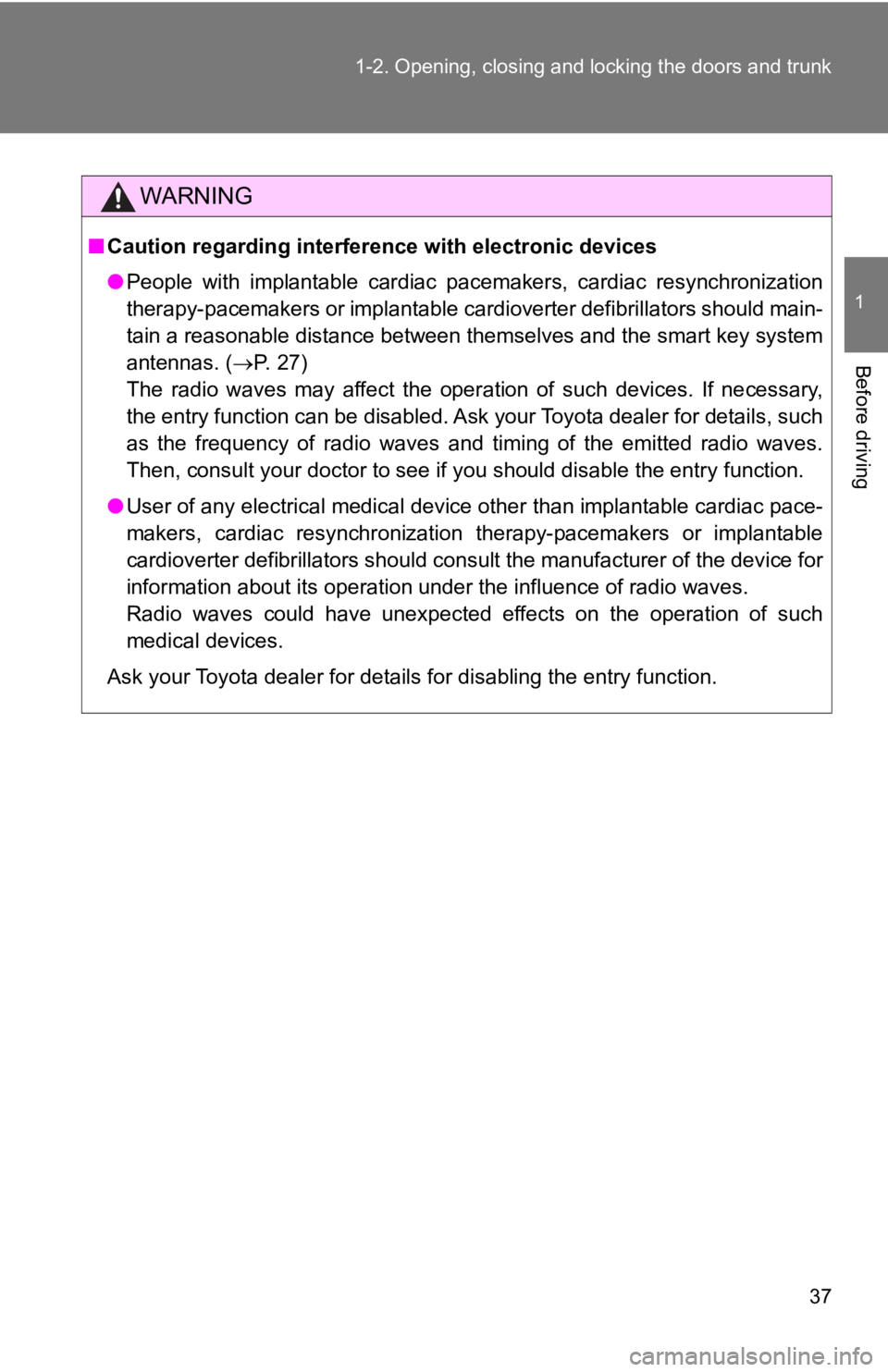
371-2. Opening, closing and locking the doors and trunk
1
Before driving WARNING■ Caution regarding interference with electronic devices
● People with implantable cardiac pacemakers, cardiac resynchronization
therapy-pacemakers or implantable cardioverter defibrillators s hould main-
tain a reasonable distance between themselves and the smart key system
antennas. ( P. 27)
The radio waves may affect the operation of such devices. If ne cessary,
the entry function can be disabled. Ask your Toyota dealer for details, such
as the frequency of radio waves and timing of the emitted radio waves.
Then, consult your doctor to see if you should disable the entr y function.
● User of any electrical medical device other than implantable cardiac pace-
makers, cardiac resynchronization therapy-pacemakers or implant able
cardioverter defibrillators should consult the manufacturer of the device for
information about its operation under the influence of radio wa ves.
Radio waves could have unexpected effects on the operation of s uch
medical devices.
Ask your Toyota dealer for details for disabling the entry func tion.
Page 42 of 532

421-2. Opening, closing and locking the doors and trunk
■ When the electronic key battery is fully depleted
P. 363
■ Confirmation of the registered key number (vehicles with a smar t key
system)
The number of keys already registered to the vehicle can be con firmed. Ask
your Toyota dealer for details.
■ Customization that can be conf igured at your Toyota dealer
Settings (e.g. wireless remote control system) can be changed.
(Customizable features P. 487)
■ Certification for wir eless remote control
For vehicles sold in the U.S.A.
FCC ID: HYQ23AAC FCC ID: HYQ12BEL
NOTE:
This device complies with part 15 of the FCC Rules. Operation i s subject to
the following two conditions: (1) This device may not cause har mful interfer-
ence, and (2) this device must accept any interference received, including
interference that may cause undesired operation.
FCC WARNING:
Changes or modifications not expressly approved by the party re sponsible
for compliance could void the user's authority to operate the equipment.
For vehicles sold in Canada
NOTE:
This device complies with Industry Canada’s licence-exempt RSSs . Opera-
tion is subject to the following two conditions: (1) This devic e may not cause
interference; and (2) This device must accept any interference, including
interference that may cause undesired operation of the device.
NOTE:
Le présent appareil est conforme aux CNR d’Industrie Canada app licables
aux appareils radio exempts de licence. L’exploitation est auto risée aux
deux conditions suivantes: (1) l’appareil ne doit pas produire de brouillage;
(2) l’utilisateur de l’appareil doit accepter tout brouillage r adioélectrique subi,
même si le brouillage est susceptible d’en compromettre le fonc tionnement.
Page 45 of 532

451-2. Opening, closing and locking the doors and trunk
1
Before driving ■ Window open/close function linked to door operation
In order to make opening and closing the doors easier, complete ly closed
windows are linked to door operations. Therefore, when a door is opened, its
window opens slightly. When a door is closed, its window closes completely.
However, if the battery has discharged or is disconnected, this function will
not operate. ( P. 448)
■ If the smart key system has been deactivated in a customized se tting
(vehicles with a smart key system)
Use the wireless remote control or mechanical key. ( P. 38, 440)
WARNING■ To prevent an accident
Observe the following precautions while driving the vehicle.
Failure to do so may result in a door opening and an occupant f alling out,
resulting in death or serious injury.
● Always use a seat belt.
● Always lock both side doors.
● Ensure that both side doors are properly closed.
● Do not pull the inside handle of the doors while driving.
The doors may be opened and the passengers are thrown out of th e vehi-
cle and it may result in serious injury or death.
Page 49 of 532
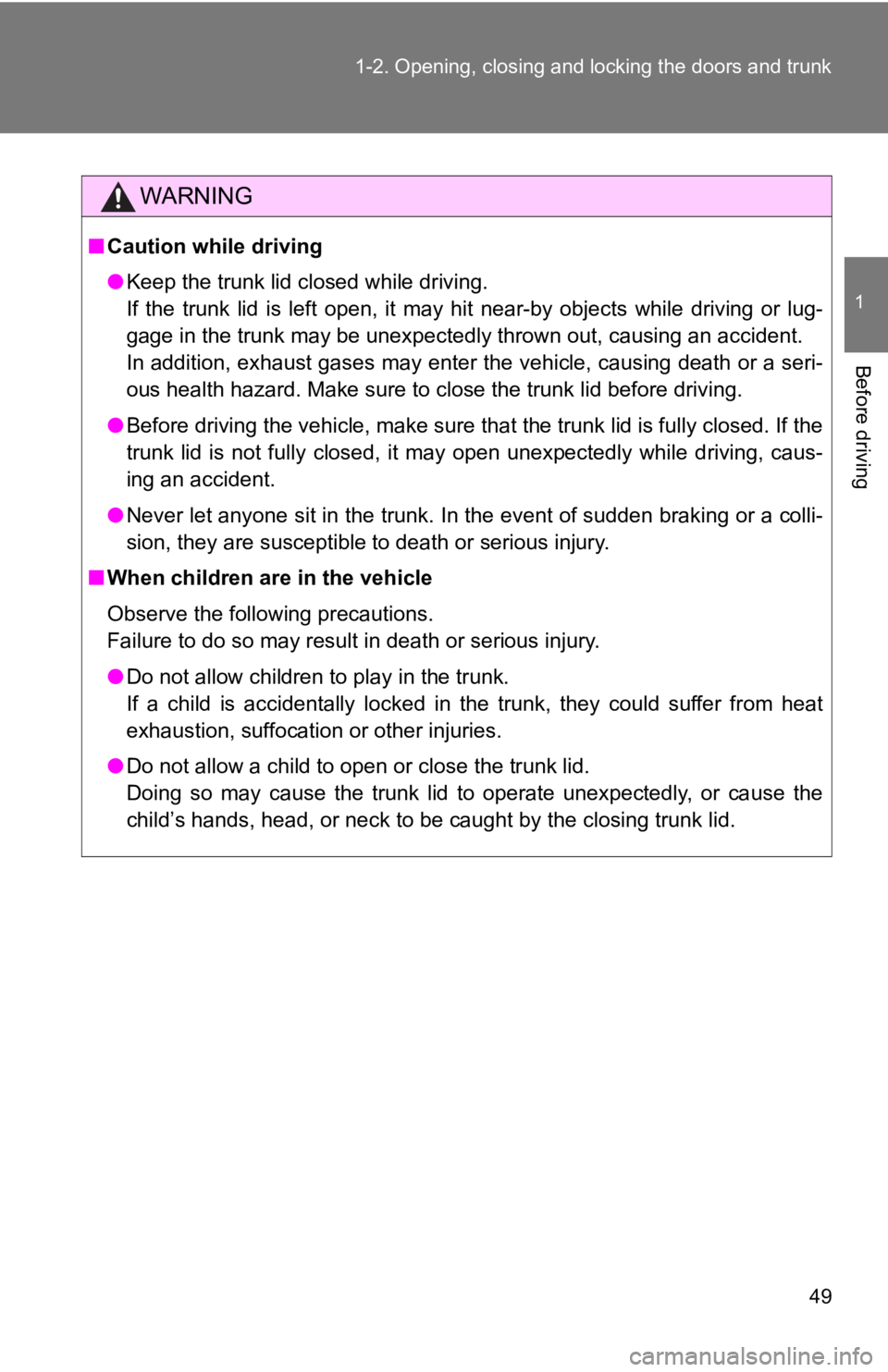
491-2. Opening, closing and locking the doors and trunk
1
Before driving WARNING■ Caution while driving
● Keep the trunk lid closed while driving.
If the trunk lid is left open, it may hit near-by objects while driving or lug-
gage in the trunk may be unexpectedly thrown out, causing an ac cident.
In addition, exhaust gases may enter the vehicle, causing death or a seri-
ous health hazard. Make sure to close the trunk lid before driv ing.
● Before driving the vehicle, make sure that the trunk lid is ful ly closed. If the
trunk lid is not fully closed, it may open unexpectedly while d riving, caus-
ing an accident.
● Never let anyone sit in the trunk. In the event of sudden braki ng or a colli-
sion, they are susceptible to death or serious injury.
■ When children are in the vehicle
Observe the following precautions.
Failure to do so may result in death or serious injury.
● Do not allow children to play in the trunk.
If a child is accidentally locked in the trunk, they could suff er from heat
exhaustion, suffocation or other injuries.
● Do not allow a child to open or close the trunk lid.
Doing so may cause the trunk lid to operate unexpectedly, or ca use the
child’s hands, head, or neck to be caught by the closing trunk lid.